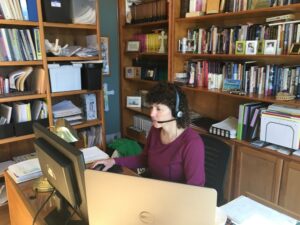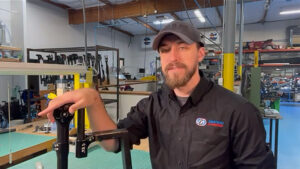How Do I Learn More About Seating and Wheeled Mobility?
Michelle L. Lange, OTR/L, ATP/SMS and Greg Peek, President
One of the most common questions people ask me is how to increase their knowledge in the area of Seating and Wheeled Mobility. The answer, in part, depends on your learning style and preferences. Combining various learning opportunities increases skills faster and more thoroughly.
 In-Person Education and Exhibit Halls
In-Person Education and Exhibit Halls
I sure missed live education during the Covid pandemic! In-Person education provides an opportunity to hear from a subject matter expert on a specific topic, to join in a discussion, to ask questions, and hear answers. Personally, I learn well from this type of education. Often, In-Person education is a part of a conference where a number of different topics may be presented. Content is typically approved for Continuing Education Units (CEUs). A regional, national, or even international conference is also likely to include exhibits – an opportunity to see a wide variety of seating and wheeled mobility equipment, ask questions of manufacturers, provide feedback, and actually try things out. Conferences can be great for networking, as well.
Your local complex rehab technology (CRT) supplier or a specific manufacturer may offer regional education. The most comprehensive national conference in the United States is the International Seating Symposium (https://www.iss.pitt.edu/) which will be held next in Pittsburgh, PA in 2025. This conference offers introductory through advanced content.
 Virtual Education
Virtual Education
Virtual Education, such as live and recorded webinars, are very popular. Instead of the time and cost of traveling to a conference, you can watch a webinar from just about anywhere and anytime – even in your PJs! Live webinars typically include time for questions and comments, though are not as interactive as an In-Person event. Virtual education is available through a number of Educational Platforms. For Occupational and Physical Therapists, this includes companies such as Continued, MedBridge, and Colibri. Specific Seating and Wheeled Mobility content will vary between platforms. Many CRT suppliers and Manufacturers also offer virtual education. Look for content at a level that meets your needs.
Written Material
If you learn better through reading, numerous Blogs, Articles, and Texts are available. Many manufacturers’ websites include blogs and articles. NRRTS Directions and Mobility Management are both complimentary trade magazines packed with helpful information. Several Journals include current research in Seating and Wheeled Mobility, particularly Disability and Rehabilitation: Assistive Technology (https://www.tandfonline.com/journals/iidt20) and RESNA’s Assistive Technology (https://www.resna.org/Membership/Assistive-Technology-Journal). Some texts include 1-2 chapters on this practice area, however Seating and Wheeled Mobility: a clinical resource guide, 2nd ed. addresses the depth and breadth of the subject (https://www.routledge.com/Seating-and-Wheeled-Mobility-A-Clinical-Resource-Guide/Lange-Minkel/p/book/9781630913960).
Mentoring
A great way to learn more about any subject is to work with a Mentor. The Mentee may begin with simple observation, moving on to assisting the Mentor, practicing under the Mentor’s supervision, and finally flying solo. You can contact subject matter experts in your area and ask if it would be possible to observe in their seating and mobility clinic, for example. Bring them chocolate!
 Hands On
Hands On
Most people tell me they learn best through Hands-On time with the equipment. This works well for me, as well! Remember, however, that other education is required to develop and maintain a foundation from which to apply CRT equipment appropriately. With that said, learning how to install, adjust, program, etc. specific equipment does work best when our hands are in the mix.
Experience
There is really no substitute for ‘on-the-job’ training. This is a broad field so don’t get pigeonholed in one little area. Seek out additional client populations and technologies to work with. There is a lot to learn. This is true for clinicians as well as suppliers.
Perhaps you are not an ATP. Perhaps you are an RTS, technician, delivery driver or completely new to this field and like the idea of working hands-on with people who need help with their seating and mobility. It’s a big broad field so don’t be afraid to start in the kiddie pool and utilize these resources to work your way up to the high board.
Seating Dynamics
- Seating Dynamics provides In-Person Education regularly at Regional, National, and even International In-Person events. Seating Dynamics also offers a wide range of Live and Recorded Virtual Education on our website at https://www.seatingdynamics.com/courses/.
- Our website includes a plethora of Blog topics (https://www.seatingdynamics.com/blogs/) and published articles on Dynamic Seating and related content (https://www.seatingdynamics.com/articles/).
- Our “How To” Videos can guide you in Hands-on learning (https://www.seatingdynamics.com/videos-how-to/).
- Finally, if you are exploring opportunities to learn from a mentor, let us know! We would be happy to help you find someone in your area or work with you long-distance to sharpen your skills!

Hello,
I am a COTA/L, ATP and have worked in the custom wheelchair seating industry for close to 30 years. I work alongside some very creative seating technicians who build individualized seating systems for clients with a range of diagnoses. I am the clinical liason between the evaluating therapist and the seating technician. Together we are constantly problem solving, experimenting and sometimes starting over until our clients are as functional as they can be!
I certainly don’t know everything there is to know about custom seating and wheeled mobility, but if I can answer questions for someone or to problem solve a difficult situation, I would be willing to help .
Thanks so much Mary for your contributions to this field and your willingness to help others! Keep up the great work!